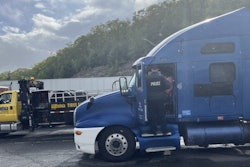As trucking and safety groups form new alliances in the debate over speed governing, the real motives are hard to pinpoint. Is speed the real villain, or is safety a “Trojan horse” for another agenda?
“What is really behind the push for an across-the-board 68 mph limit on all big trucks?” So asks River Transport owner-operator Robert Harsell of Greenville, Va., in his submitted comments on the speed governor petitions before the U.S. Department of Transportation.
That question has been at the front of many owner-operators’ minds since the filing of two requests that heavy trucks be governed at 68 mph – one by the American Trucking Associations, one by 10 trucking fleets and Road Safe America, an Atlanta-based safety advocacy group. The proposals have produced some strange bedfellows as trucking and safety groups staked their positions.
While no one questions that the lower speeds would save fuel, few agree about their impact on productivity or on the major issue, safety. Also unclear is whether speed governing is a “Trojan horse” for other issues dear to carriers, as the Owner-Operator Independent Drivers Association claims.
The comment period ended March 27, and the Federal Motor Carrier Safety Administration expects to make an announcement by year’s end. That ruling could run the gamut from outright denial to a policy directive to a formal rulemaking, the agency says. However, the issue’s complexity, particularly its potential cost to truck manufacturers and shippers, would seem to dictate a rulemaking if accepted.

ATA wants tamperproof, manufacturer-set top speeds of 68 mph on new trucks only. Road Safe asks for a governed 68 mph on all tractors manufactured after model year 1990.
“These petitions are intended to be a Trojan horse for the true objectives of big trucking companies – doing away with current truck size and weight restrictions as well as increasing their importation of cheap, less qualified foreign drivers,” says Todd Spencer, Owner-Operator Independent Drivers Association executive vice president. Universal governing also would protect the interests of carriers – mainly large ones – that now limit truck speeds but must compete with other carriers that offer drivers ungoverned trucks.
ATA Safety Vice President Dave Osiecki says OOIDA’s claim is a false “sound bite” that the organization “throws out there because it gets printed.” Osiecki says the speed-governor issue has nothing to do with productivity and is only about safety.
The push for higher truck weight goes back to at least 1999, when federal legislation was proposed that would mandate a recommendation to states to raise the maximum GVW from 80,000 pounds to 97,000 pounds on tractor-trailers with one extra trailer axle. The legislation was pushed by Americans for Safe and Efficient Transportation, a single-issue lobby with members including ATA, but never got out of committee.
ASET Director Jake Jacoby says that while the organization currently is in limbo, the weight issue is not.
In a lament on ASET’s website (aset-safety.org) in 2005, Jacoby says including state weight-increase pilot projects in that year’s highway reauthorization bill was actively pursued, but failed. Last year there was speculation that another trucking industry campaign for weight increases would accompany the next highway reauthorization in 2009.
But in March 2007, days before the comment period on the speed governor petitions ended, the provision surfaced in the Security and Fuel Efficiency (SAFE) Energy Act (S. 875), sponsored by U.S. Sens. Byron Dorgan, D-N.D., and Larry Craig, R-Idaho. Each received campaign contributions between 2002 and 2004 from ATA, FedEx and UPS, with Craig receiving a contribution from Yellow Corp. as well. At press time, the bill was being considered by the Senate Finance Committee.
SAFE covers energy issues far beyond trucking. It closely follows recommendations made by the Energy Security Leadership Council, a task force of industry, government and military representatives charged with reducing America’s dependence on foreign oil. Among transportation representatives on the council are the co-chair, FedEx President and CEO Frederick Smith, and UPS chief executive Michael Eskew.
The task force’s final report recommends increasing the weight limit and cites the much higher weight limits in Europe and Canada as models. European trucks, particularly, have a speed and weight mix far different from current U.S. standards: Trucks are governed at the equivalent of 57 mph, but standard maximum weight is the equivalent of 110,000 pounds. Because force increases exponentially with speed, the speed reduction is enough to significantly reduce the vehicle’s kinetic energy compared to that of a lighter truck traveling at maximum speed in the United States. The lower speed also reduces accident risk.
Now a highway policy consultant for the National Industrial Transportation League, Jacoby says he’s spoken with representatives of the task force, with Dorgan and with Craig staff members about increased truck weights, but that ASET was not officially involved in developing the proposed legislation. He does, however, credit ASET’s years of lobbying for raising awareness about it.
Don Osterberg, safety vice president at Schneider National, says he opposes a weight increase because of safety concerns, but that with advancements in braking technologies, the future holds a safe solution for larger vehicles. Osiecki says increased truck weight never has been part of the planning discussions on the speed governor petitions.
Even so, the physics of kinetic energy show that decreasing speed from 75 mph to 68 mph, an interval noted in comments separately submitted by Osterberg and by Road Safe, almost exactly compensates for the additional force that would be created by increasing weight from 80,000 to 97,000 pounds.
Osiecki says the primary factor in choosing 68 mph is ATA’s highway speed limit policy: 65 mph for all vehicles. Osterberg, a member of the ATA committee that helped develop the speed governor policy, says the extra 3 mph is primarily to give drivers, in the event of a steer-tire blowout, the chance to regain control by accelerating, thereby lessening front-axle pressure. For the same reason, he says, Schneider trucks are governed at 65, but their cruise controls are governed at 63.
ATA has no campaign to lower speed limits in states where they exceed 65, a majority of the country, but the association is in conversation about it with state governments and trucking associations, Osiecki says. If cars won’t slow down, if local law enforcement won’t enforce existing limits, if elected officials won’t get behind lower limits because of politics, at least the trucking industry can lead by example, he says.
“Speed limits are going in the wrong direction, and they need to come back down,” Osiecki says.
If trucks slow down across the board, Osterberg says, “that certainly could drive future considerations in slowing everybody down.”
Slower average speed appears to result in reduced productivity, because shipping rates and drivers’ pay rates largely are based on miles. A speed cap can handicap a carrier, says Sherwin Fast, president of Great Plains Trucking of Salina, Kan.
“How do you think it would go over if the government passed a law that said every retail store had to set their prices the same to level the playing field?” he asks in his submitted comments. He adds: “I think it’s big money, big trucking companies, that are trying to level the playing field.”
In his submitted comments, owner-operator Mike Simmons of Murrells Inlet, S.C., accuses the petitioners of attempting to drive small businesses out of trucking. “This is their way of controlling the industry,” he says.
Osterberg sees no correlation among speed, productivity and competitive advantage. When Schneider upped the maximum governed speed on its trucks from 55 mph to 65 mph in 1996, many in the company predicted a productivity gain. It didn’t happen, Osterberg says, due to the increased costs associated with speed, such as fuel, equipment longevity and accidents.
Should a heavier weight limit become part of the equation, the impact of speed on productivity gets more difficult to evaluate. While slower trucks are less productive, bigger trucks are more productive. Also, bigger loads and fewer trips at slower speeds would be consistent with the nation’s current fuel-efficiency and emissions-reduction priorities. Fewer truck trips also could slow the growth rate of congestion.
These heavier trucks, Jacoby says, would look no different from today’s trucks but for the sixth axle and would handle “almost identically to an 80,000-pound, five-axle vehicle. The two additional anti-lock brakes and the more even distribution of weight across six axles offset the extra weight added to the truck.”
“The only question remaining for our highway system,” Jacoby says, “is do we want an ever-increasing number of 80,000-pound trucks on the road, or do we want fewer, just as safe, 97,000-pound trucks?”
CHOOSING SIDES
In favor
American Trucking Associations
Road Safe America
Insurance Institute for Highway Safety
Governors Highway Safety Association
OPPOSED
Owner-Operator Independent Drivers Association
Truckload Carriers Association
The Partnership for Safe Driving
Neutral
National Private Truck Council
OTHER PATHS TO SAFETY
Owner-operators are among those offering a myriad of alternate ways to reach the safety goals cited in the speed governor petitions. Here are four culled from comments in the public docket.
IMPROVE TRAINING STANDARDS. “Driving too fast for conditions has nothing to do with the truck and everything to do with the truck driver. Regulations will do little to help this situation compared to proper training.” – Tom J. Kuechenmeister, Brookings, S.D.
ELIMINATE DRIVER DISTRACTIONS. “Have you seen the Allstate commercial where the guy in the car is drinking his coffee, suddenly drops his cup, places both hands on the wheel and braces himself while slamming on the brakes before hitting the stopped vehicle in front of him? The announcer says, ‘Antilock brakes, airbags, etc; all the safety equipment we can place into an automobile won’t make it any more safe without the driver paying attention.’ That goes for ‘speed limiters’ also.”
– Michael Babella, Quapaw, Okla.
MANDATE ADAPTIVE CRUISE CONTROL. “If the DOT has reached the conclusion that driver attitude/behavior modification is not possible









